Partner: Sarah Waxman
When I went to the Simon Bolivar hospital in Bogota, Colombia, I visited children with high degree burn wounds. One of the things I noticed during my visit was that the children with burn wounds on their face couldn’t blow air with their mouth. During my research for my midterm project, I searched for the reasons behind this. Their burn wounds partially paralyzed the children’s faces, which is why they couldn’t practice out specific actions. This visit gave me the idea to create some device that would help these children. Furthermore, by working on this project, I learned that people with facial paralysis have difficulty blowing out air.
I didn’t think I was able to create something that will help people in their daily lives, but instead of creating something fun and entertaining, I did end up creating something that is yet interactive, yet a device that actually to helps certain people. For many of us, the simple action such as blowing air seems to come naturally, and we don’t even take the time thinking about that ability. However, there are people out there who physically cannot practice such a simple action, an action that many of us take for granted. At first, I had in mind to create something fun, since I thought it was more relevant at my level of the class, and from what we have learned during the recitations, to create an entertaining device. However, throughout the class, I learned that computers, coding, and some materials could replace many of the human abilities. This helped me to carry out a project that could replace a basic fact such as blowing. Besides this, I had the opportunity to see some projects of my colleagues to find inspiration. Then, ultimately, I realized that to create a unique plan, one has to look for his or her own experience and personal perception of interaction to create something unique and meaningful. Something that helped me to create this project was the idea of putting myself in other people’s situation and thinking about how a project could overcome my limitations and thus those of others as well. Even though my project might seem simple, the most challenging thing was to create an idea and turn it into something concrete. There is nothing more rewarding than creating something with a purpose beyond entertainment. My primary target audience for my project are children that suffer from burn wounds in their face which aren’t able to blow. Which might seem to be a small target audience, but, in my personal opinion, these smaller audiences deserve my attention and time just like any other audience would.
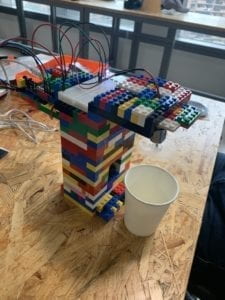
My partner and I wanted to create something simple, jazzy, and portable. In the beginning, our first model draft for “Chacool” was made out of Legos. After the user testing session, one of the things that captivated the audience the most was the fact that it was made out of Legos. Therefore, this not only made us realize that our final model was going to be armed with Legos but also the Legos and their striking colors were perfect for our targeted audience (kids). We wanted to design something compact and easy to carry. So, the first thing that we had to ensure is that all the necessary components should be inside the product. For example, the breadboard, the Arduino, the sensors, and the fan should all be in one piece. The second problem was that the energy should come from the product (to be able to make it portable), so we installed a battery holder on the back side. All this was easy to assemble since the Legos can be manipulated very quickly to create the necessary design. The design had to be practical and self-explanatory to create a truly interactive project. We did not want our audience to have to work hard to understand or interact with “Chacool”. So, we made a platform with the fan at the bottom indicating where the glass should go. We also put a light (on the top of the platform) to provide faster feedback indicating when the fan was working at full power and when not. One of the other options instead of using Legos was to use the laser cutter to create the design. But this option was discarded because there is nothing better for children than using Legos (and their bright colors). One of the things that I regret having not placed was some eyes or some toys that hid the sensor. Since placing another element covering the sensor would have contributed a friendlier personality to “Chacool.”
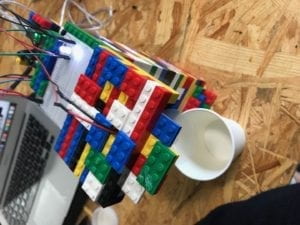
As I mentioned before, one of the things we decided in the user testing session was that we should keep the Legos from other materials. We also learned and realized that sometimes when creating an interactive project, one has to provide some kind of immediate feedback so that the person understands that the plan is working. So, with the help of Young (our teacher), we decided to place a light that indicated when the sensor perceived some kind of approach. One of the most significant problems we faced was the use of the sensor. At first, we wanted a heat sensor (to say the temperature of the drink), but then we discovered that the sensor cables interfered with the positioning of the vessel, and also the heat sensor was not strong enough to activate the fan motor. The second sensor that we used was the one of movement, this sensor in spite of which it had the power to activate the motor; it did not help us to control the power of the motor (it was or powerful or, it did not move). The third sensor we used (and our final sensor) was the distance sensor, since this sensor was enough to detect the movement, we could also control the power of the motor (the closer the cup, the stronger the fan), and even helped us that the Led light could fade with the distance of the glass. The only problem we had with this sensor was that sometimes the signal was not strong enough to activate the motor. Even though we changed the distance several times, we always had this problem. On the other hand, we had several issues with the engine, because sometimes if you put the engine upside down, it does not have the same potency that if you put it face up (given the weight of the fan). So sometimes (rarely) you just needed to move the fan to a little bit for it to activate.
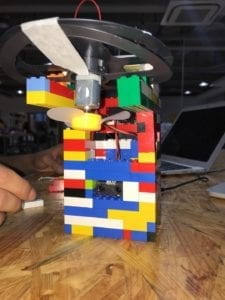
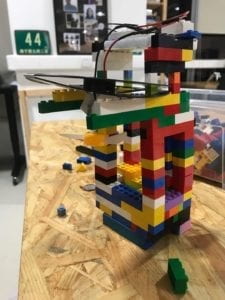
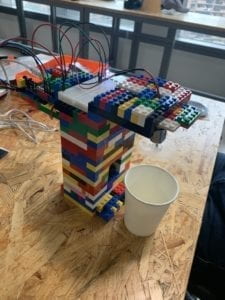
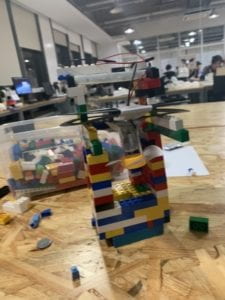
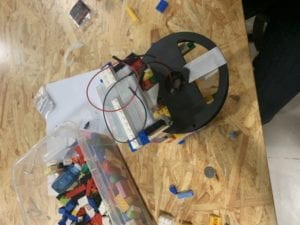
My definition of interaction is: interaction begins when certain things or organisms establish a reciprocal interrelation where, through a connection, one body or thing influences the other and causes it to respond in a relative (understanding) manner. Therefore, I think that my project aligns with my definition of interaction because when someone puts a glass in the “Chacool,” the project can understand the action and respond in an appropriate manner, establishing a reciprocal relationship. For example, when putting the glass, the fan activates, and a light turns on giving immediate feedback, which allows the user to understand in a faster way the action emitted by the project. Also, the project is simple, which makes it more user-friendly, and makes the relationship more efficient. The project depends strongly on the human, and the human in a certain way depends on the project. I am creating an interactive relationship between two factors that are very easy to perceive. The project is quite straightforward which really facilitated my intervention with the audience, since my explanations of how it worked were minimal, and the audience perfectly understood the purpose of the project.
I want to take this conclusion from a different approach. The following is the most honest advice I can give you about interaction and my project. There is nothing more rewarding than having an idea, a vision, and a goal, and therefore turning it into something concrete (and even more with a purpose). With the greatest humility, I always saw technology projects, I saw how people created robots, machines, and whatnot, and never in my life did I think that I could create something even similar. I consider myself more of a finance person, so I never thought that I would end up in a class where I would have to build something based on technology and interaction. But over time of the course, and by understanding what interaction meant, I learned how much humans depend on interaction and how it can help us. Therefore, this helped me to, explore, understand, and create an idea even if it is small into something real. The moment I put the first glass and the fan was active; I had never felt more accomplished. It might be something little, but for me, it meant a lot. It is true that we need certain knowledge and certain materials to create this type of projects. But if you have an idea (even simple), try to build it, because you never know the feeling that can bring you, or how this idea can help someone. My project compared to that of my colleagues was not the most sophisticated or interactive, but for me, it had a great purpose, and I made it real, and this for me has more value than any other project. Tell me how crazy it is that with some coding, some small materials, and a computer you create a project that responds to humans, is just mind-blowing.